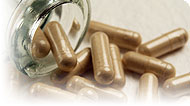Penn Herb Wellness Guide
Vitamin DFind Products

How to Use It
People who get plenty of sun exposure do not require supplemental vitamin D, since sunlight increases vitamin D synthesis when it strikes bare skin. Although the recommended dietary allowance for vitamin D is 200 IU per day for adults, there is some evidence that elderly people need 800 to 1,000 IU per day for maximum effects on preserving bone density and preventing fractures.1, 2, 3, 4 Sun-deprived people should take no less than 600 IU per day and ideally around 1,000 IU per day.5, 6
Where to Find It
Cod liver oil is an excellent dietary source of vitamin D, as are vitamin D-fortified foods. Traces of vitamin D are found in egg yolks and butter. However, the majority of vitamin D in the body is created during a chemical reaction that starts with sunlight exposure to the skin. Cholecalciferol (vitamin D3) is the animal form of this vitamin.
Possible Deficiencies
In adults, vitamin D deficiency may result in a softening of the bones known as osteomalacia. This condition is treated with vitamin D, sometimes in combination with calcium supplements. Osteomalacia should be diagnosed, and its treatment monitored, by a doctor. In people of any age, vitamin D deficiency causes abnormal bone formation. In addition, vitamin D deficiency can cause muscle weakness, which improves with vitamin D supplementation.7 Vitamin D deficiency occurs more commonly following winter, owing to restricted sunlight exposure during that season. Living in an area with a lot of atmospheric pollution, which can block the sun's ultraviolet rays, also appears to increase the risk of vitamin D deficiency.89
Vitamin D deficiency is more common in strict vegetarians (who avoid vitamin D-fortified dairy foods), dark-skinned people,10 alcoholics, and people with liver or kidney disease. People with liver and kidney disease can make vitamin D but cannot activate it.
Vitamin D deficiency is more common in people suffering from intestinal malabsorption, which may have occurred following previous intestinal surgeries, or from celiac disease.11 People with insufficient pancreatic function (e.g., those with pancreatitis or cystic fibrosis) tend to be deficient in vitamin D. Vitamin D deficiency is also common in individuals with hyperthyroidism (Graves' disease), particularly women.12
In children, vitamin D deficiency is called rickets and causes a bowing of bones not seen in adults with vitamin D deficiency. Vitamin D deficiency is common among people with hyperparathyroidism, a condition in which the parathyroid gland is overactive. In a study of 124 people with mild hyperparathyroidism, vitamin D levels were below normal in 7% of them and suboptimal in 53% of them.13 Vitamin D deficiency is also common in men with advanced prostate cancer. In one study, 44% of 16 men with advanced prostate cancer had decreased blood levels of vitamin D.14
One in seven adults has been reported to be deficient in vitamin D.15 In one study, 42% of hospitalized patients under age 65 were reported to be vitamin D deficient.16 In this same study, 37% of the people were found to be deficient in vitamin D, despite the fact they were eating the currently recommended amount of this nutrient. Vitamin D deficiency is particularly common among the elderly. Age-related decline in vitamin D status may be due to reduced absorption, transport, or liver metabolism of vitamin D.17
Best Form to Take
Vitamin D3 (cholecalciferol) is the form of vitamin D produced in the skin from sunlight exposure, and is also the form of vitamin D present in food. As a supplement, therefore, it is to be preferred over vitamin D2 (ergocalciferol).18
Copyright 2026 TraceGains, Inc. All rights reserved.
Learn more about TraceGains, the company.
The information presented by TraceGains is for informational purposes only. It is based on scientific studies (human, animal, or in vitro), clinical experience, or traditional usage as cited in each article. The results reported may not necessarily occur in all individuals. Self-treatment is not recommended for life-threatening conditions that require medical treatment under a doctor's care. For many of the conditions discussed, treatment with prescription or over the counter medication is also available. Consult your doctor, practitioner, and/or pharmacist for any health problem and before using any supplements or before making any changes in prescribed medications. Information expires December 2026.


